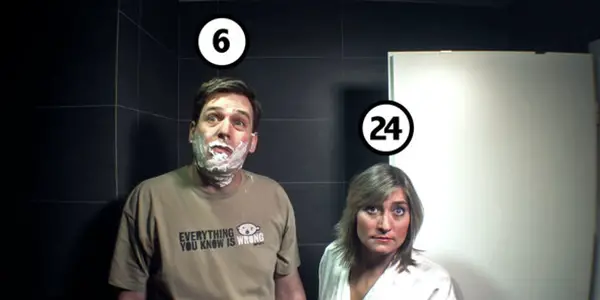From Filmmaker To Film Festival Director: An Insider’s Guide

Jax is a filmmaker and producer, and a film &…
As readers may or may not know, I took a break from writing these past few months as I was running my first ever film festival. The Drunken Film Fest (DFF) had its inaugural year in Bradford, England this past summer and it was pretty successful for a first year free film festival, if I do say so myself.
However, my background when it comes to festivals is not in running them, but rather in trying to get accepted to them. This placed me in a unique position when it came to screening and selecting, and my experience running the festival has certainly taught me a few things both about festivals and about independent filmmaking. After this amazing adventure, I thought I’d share what I had learned.
This is by no means meant to be taken as a rule book. Every film festival is different and will have certain criteria they are looking to fill. Nonetheless, I definitely feel some of these “insider tips” will be more or less universal. A word of caution, though: just because someone says that the best way to do something is “A” doesn’t mean you can’t do “B” or “C’ or even “Q”. The whole point of art is that we have different tastes. But if you want to subvert the form, you have to be prepared for rejection. This guide is just here to throw some advice that I have personally picked up on and think is good practice for anyone submitting to festivals.
Many of these tips are geared more towards people making shorts, but I will definitely try to include tips for our feature length indie filmmakers out there.
Screening Length
This is a belief I already had as a filmmaker, but after sifting through around 1,300 film submissions in the space of a couple months, I feel more strongly than ever that short films really should be short. By that, I mean under ten minutes, preferably around five to seven minutes. Why? Well, sorry to mess with your vision, but logistically it’s just easier to program. Secondly, if your short film is over ten minutes, it better hold my attention the entire time and feel neither too long nor too short.
An audience forgives a feature film of slow moments and a bit of dragging, but a short film time is so compressed that you need to make every second count. Alternately, many short films suffer from a sort of miniaturised feature film complex and try to work a three-act structure into the format. Sometimes it works, but more often than not the film leaves the viewer feeling that they should’ve been watching a feature film that allowed for the proper exploration and delineation of the plot points.

Either way, when you’re going through screeners and see double digits in the timecode, it’s an immediate downer for the person watching – and that puts your film at a disadvantage before it’s even been seen. The screening teams have so many films to watch (and believe me, they want to watch them all but it is overwhelming), but it’s just easier to watch a film that you only need to dedicate a few minutes to – because sometimes that’s all you have. From a programming standpoint (and on larger festivals your screeners and programmers will be different people, but I did both for DFF), films under ten minutes are great because it allows you to accept more overall.
So when it comes to accepting longer shorts, screeners hold them up to a higher scrutiny because they take sometimes double or triple the amount of screening time than the other films. If I’m making my audience sit through a film three times the average length of the others, they better be talking about it non-stop afterwards. A great example of this was a Russian film we showed at DFF called Shredder – it was around 20 minutes in length but captivating, and two months later people are still mentioning it to me when I see them.
First Impressions
Just like meeting new people, first impressions are super important when it comes to submitting your film to festivals. Make your first few minutes strong. This might seem obvious – you want your whole film to be strong, of course. But, and this ties into the screening length issue, when you’re trying to get through literally thousands of films and narrow them down, you may only watch the opening sequence of a film before rejecting it. If I’m not interested in a short film after two minutes, that is potentially 50% of it that I found boring. Feature films have a bit more luxury with pacing because there’s so much time for the filmmaker to be deliberate. But short films really need to get their point across quickly.
So what you need to do as a filmmaker is to make sure you have a compelling opening that makes your audience not only willing to keep watching, but makes them need to. If you can help it, I don’t recommend an overly-ambiguous opening. Do not confuse or bore your audience. Do not have an extended credits sequence. In fact…
Credits Are a Killer
Hang on, I don’t mean that you should not include credits. People worked hard and deserve to be recognised. But if you make a short film under ten minutes, and your credits sequence (either opening or closing) is two of those minutes, that is an astounding ratio of content to words on a screen that nobody has the time or inclination to sit through. This can seriously backfire on you as a filmmaker, and really effect how an audience receives your film. The best example from DFF was a music video that had a very long closing credits sequence over black and silence. Even though the video was beautifully shot and very well made, the only thing anyone mentioned was to joke about the credits being longer than the video itself.

Do yourself and your audience a favour and run your credits very quickly at the end. Don’t leave anyone out, but don’t kid yourself. Film students in particular seem very fond of long credits sequences (I’ve been guilty of this myself – see this film I made as a student). While you might think you’re adding a professional look to your film, you’re really just making it that much harder to program.
Do Some Research
This is another point that might seem a bit obvious, but there were enough films that came through that either had done no research or disregarded the research they did do. The big one is claims about being ‘based on a true story’. We live in the age of Google. The ‘true story’ is a click away, so don’t assume it won’t be checked, especially if it’s a risqué or edgy subject matter. Some festivals won’t care, but if they have a sense of integrity they probably will (and you should have the pride to care too!).
Research doesn’t stop at your film – if you are interested in particular festivals, pull up their websites and find out a bit about them. If your film is anti-American and the film festival is run by Americans, maybe it won’t get screened (this happened). On the flip side, don’t underestimate how far that personal touch goes.
Out of 1,200 submissions on Film Freeway, I got a personal email from ONE production team. All they did was contact me through the film festival email and say they loved the description on Film Freeway, and that they had submitted their own film. That put their film (a feature which we did end up selecting) right to the top of the pile, and I immediately asked a couple of the people from the screening team to check it out.
In Conclusion
The real point I’m trying to get across is to always keep in mind your audience, and in festivals that includes the screening teams. It is really easy to get sidetracked by your own vision (I’ve certainly done it), and lose your audience in the process. Be true to yourself and what you want your film to be – I would never ever suggest you compromise that – but if your goal is hitting up the film festival circuit, keep their vision in mind too.
There are exceptions to every single one of the points I made above, and I screened many of them at Drunken Film Fest. You can always break the rules, but you need to understand the rules you’re breaking. Some of the best filmmakers completely threw out the guidebook, but they always knew what they were throwing out. So go forth and create. Create art, create pop, create trash. But create.
Were these tips useful for you? Will you use them the next time you submit to festivals? Let me know in the comments.
Does content like this matter to you?
Become a Member and support film journalism. Unlock access to all of Film Inquiry`s great articles. Join a community of like-minded readers who are passionate about cinema - get access to our private members Network, give back to independent filmmakers, and more.
Jax is a filmmaker and producer, and a film & tv production lecturer at the University of Bradford and is also completing a PhD about Stan Brakhage at the University of East Anglia. In the remaining "spare time", Jax organises the Drunken Film Fest, binges bad TV, and dreams of getting “Bake Off good” with their baking.












